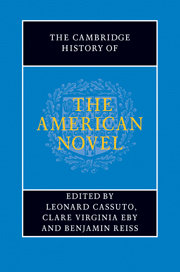Book contents
- Frontmatter
- General Introduction
- PART ONE INVENTING THE AMERICAN NOVEL
- PART TWO REALISM, PROTEST, ACCOMMODATION
- PART THREE MODERNISM AND BEYOND
- PART FOUR CONTEMPORARY FORMATIONS
- Introduction: contemporary formations
- 58 Postmodern novels
- 59 The nonfiction novel
- 60 Disability and the American novel
- 61 Model minorities and the minority model – the neoliberal novel
- 62 The American borderlands novel
- 63 The rise of the Asian American novel
- 64 Toni Morrison and the post-civil rights African American novel
- 65 Hemispheric American novels
- 66 The worlding of the American novel
- 67 The Native American Tradition
- 68 Contemporary ecofiction
- 69 Graphic novels
- 70 Twentieth- and twenty-first-century literary communities
- 71 A history of the future of narrative
- A selected bibliography
- Index
63 - The rise of the Asian American novel
from PART FOUR - CONTEMPORARY FORMATIONS
Published online by Cambridge University Press: 28 July 2011
- Frontmatter
- General Introduction
- PART ONE INVENTING THE AMERICAN NOVEL
- PART TWO REALISM, PROTEST, ACCOMMODATION
- PART THREE MODERNISM AND BEYOND
- PART FOUR CONTEMPORARY FORMATIONS
- Introduction: contemporary formations
- 58 Postmodern novels
- 59 The nonfiction novel
- 60 Disability and the American novel
- 61 Model minorities and the minority model – the neoliberal novel
- 62 The American borderlands novel
- 63 The rise of the Asian American novel
- 64 Toni Morrison and the post-civil rights African American novel
- 65 Hemispheric American novels
- 66 The worlding of the American novel
- 67 The Native American Tradition
- 68 Contemporary ecofiction
- 69 Graphic novels
- 70 Twentieth- and twenty-first-century literary communities
- 71 A history of the future of narrative
- A selected bibliography
- Index
Summary
Asian American literature falls outside the conventional criteria used to organize a literature, such as nationality, shared history, common culture, or racial identity. The term itself, Asian American, was an invention of the pan-Asian movement of the 1970s, and is used retroactively to organize and interpret a body of writing first produced when that category did not exist as a political or cultural identity. The works of the pre-1970s era were largely identified by the national origins of their writers or their subject matter as Japanese, Chinese, Korean, Indian, or Filipino American. The problem of referentiality also extends to contemporary or post-1970s literature by authors of Asian origin, fiction coeval with the category or produced in its aftermath. The civil rights struggles that birthed the term Asian American also led to the passage of the 1965 Immigration Act that profoundly changed the term's meanings. The 1965 Immigration Act reopened large-scale immigration from Asia after a hiatus of over forty years, and the influx of new immigrant and refugee populations transformed Asian Americans from a native-born to a largely foreign-born population and introduced new classes, religions, and nationalities – including Vietnamese, Hmong, Pakistanis, Sri Lankans, and Thais – to the constituency. Nevertheless, while the communities, identities, subjectivities, and affiliations the term encompasses have continuously morphed, its efficacy as a rubric is based on its analytic rather than merely descriptive force. When the Asian American movement in the 1970s birthed the political fiction of pan-ethnic identity, it reconfigured the national origin-based affiliations of Asians into an aggregate identity that emphasized a shared political history of oppression and exclusion as Asians in the United States.
- Type
- Chapter
- Information
- The Cambridge History of the American Novel , pp. 1046 - 1063Publisher: Cambridge University PressPrint publication year: 2011
- 3
- Cited by



